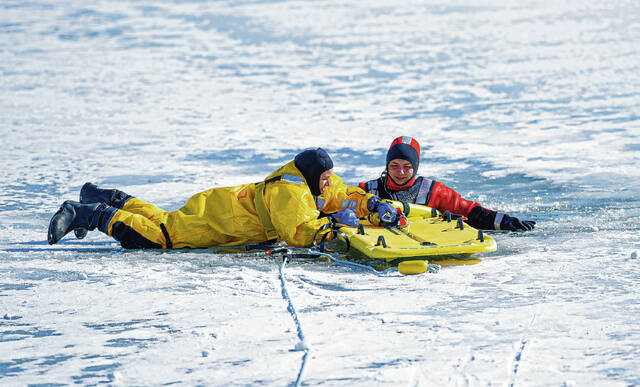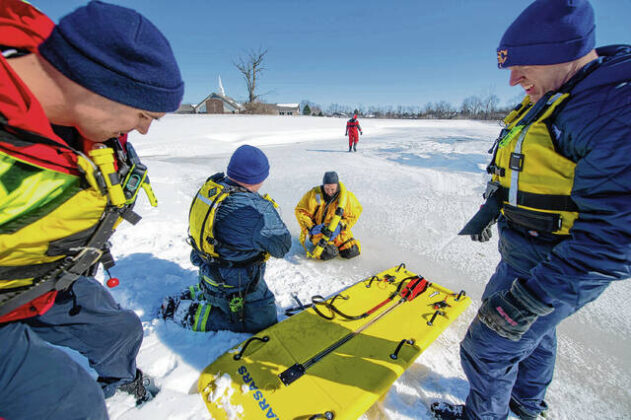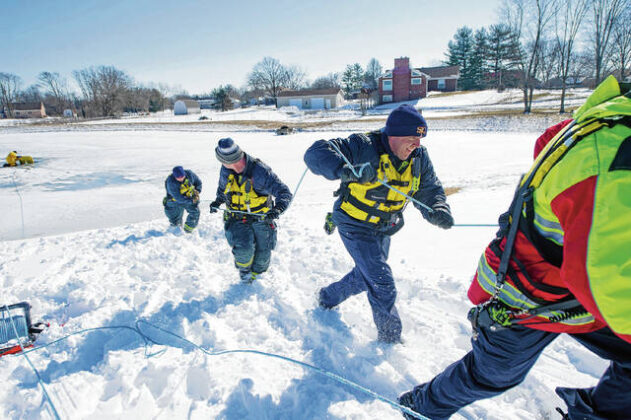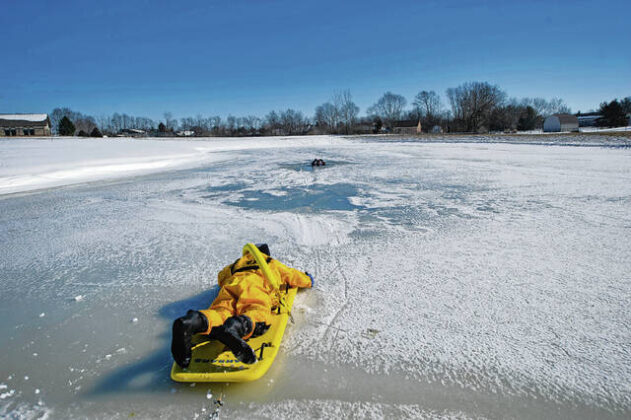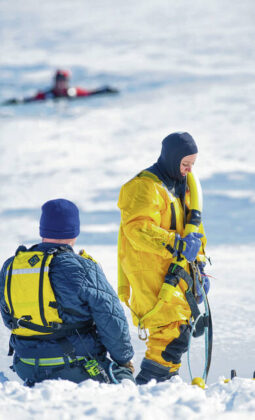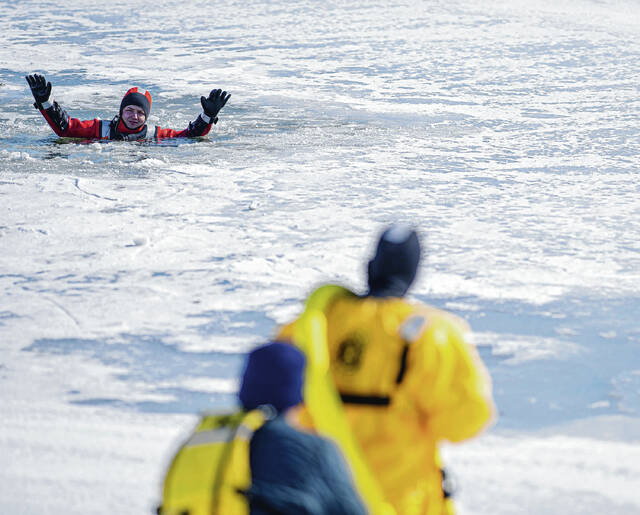
Abigail Wolf waits in a freezing pond during rescue exercises. Firefighters with Sugar Creek Township Fire Department did a little ice pond rescue training on Tuesday, Feb. 8, 2022.
Tom Russo | Daily Reporter
HANCOCK COUNTY — Dressed in a bright red ice safety suit, one firefighters call a “Gumby” outfit, firefighter Abigail Wolf was immersed in the middle of a frozen retention pond, hanging onto the edge of an ice hole that had been cut.
She was waiting to be rescued.
Several other Sugar Creek Township Fire Department A shift team members were standing around the pond behind Fire Station 45 in deep snow. They were dressed in safety gear including life jackets while laying out rescue ropes as firefighter Julie Wenning made her way onto the ice with a safety board to rescue Wolf.
Once Wenning got to the simulated victim (Wolf), she wrapped the bright yellow flotation device around Wolf, got her on the safety board and yelled at her fellow firefighters on shore to pull.
When Wolf started making headway across the ice, Wenning grabbed the bottom of her leg and hung on as they both went for a ride and were pulled to safety.
“Ice rescue training can actually be a lot of fun,” Wenning said dressed in a a bright yellow, $800 ice command rescue suit.
Despite being on a frozen pond—in and out of the ice cold water—Wenning was plenty warm, she said, sweating dressed in shorts underneath.
There isn’t always a chance for firefighters to get in the much-needed ice rescue work, so when the weather turned bitter cold recently, enough to freeze the pond behind Station 45, members of the SCTFD took advantage and worked on their lifesaving skills earlier this week.
For Wolf, who has been with the department since 2018, getting a chance to work on ice breakthrough lifesaving skills—even as the victim—was time well spent.
“I enjoy training for this because we work on different skills every time we go out there,” Wolf said.
While the ice rescue suit she had on protected her from the frigid water, she and the other first responders want residents, particularly children, to know how breathtaking falling into an ice cold pond can be.
“It will grab you,” Wolf said. “people just don’t understand what ice-cold water will do to your body.”
Lt. Will Friedericks was the commander on the most recent training with the the A shift squad and said Hancock County has been in a dangerous weather pattern lately with bitter cold temps at night and warmer temps during the day.
“All these neighborhoods here, they all have ponds on them and with a freeze, thaw, freeze pattern, the ice is unstable,” Friedericks said. “But, we know kids go out there and play on it, and that’s scary.”
Friedericks noted ice rescue can be difficult if firefighters are not properly prepared, which is why they train with a victim, a rescuer and plenty of support standing by.
“With these ice ponds, a person can get hypothermia quickly, and while this ice here looks solid, it was cracking when we were cutting a training hole,” Friedericks said.
Many modern retention ponds are created with an irrigation system in the bottom so the water flows and doesn’t ever freeze, and people need to understand that, officials said.
“While the surface might freeze, underneath the water is still moving, and that’s really dangerous,” Friedericks said.
For someone to be able to safely walk on a pond, the ice is supposed to be at least four inches thick, but with so much temperature fluctuation there just hasn’t been a chance for the ice to get to that level of thickness yet, officials said.
One of the keys to an ice rescue is having the right number of people in the right place with the right safety gear.
Ideally five to six people are needed during a first responders ice rescue, one to go into the water, one to be on standby as a back up and then four people on the rope team to pull those involved to safety.
“Fortunately, we’re finally at a place where our department has that many people on our shifts,” Battalion Chief Charlie Brown said.
The department has a habit of always packing the cold water rescue suits on their trucks because they never know when they might need them, particularly during the cold weather months.
“In this type of training, like most of our training, you just can’t get in a big hurry,” Brown said. “We tell our people to always step back, take a breath, realize what you’re dealing with and then fix the situation.”
Brown has been known to sneak out of the fire department and put on a cold weather suit—or a life jacket in the summer—and swim into the middle of a pond to wait for his crews to come and rescue him.
“We like to try and make the training realistic,” Brown said.
First responders say it’s always a good idea to remind residents there is no such thing as safe ice, SCTFD life safety and public education instructor Beth Gulley said.
She visits with students in schools throughout the area and tries to plant the seed, reminding kids to stay off the ice no matter how inviting or safe it might appear.
“We try to alert kids and families and let them know ice on ponds is never, ever a safe thing,” Gulley said. “It may look safe, but it is not.”
Officials also want to remind residents to never chase an animal or toy onto a frozen pond. In those situations, the animal will more than likely be able to find its way to safety, and the toy should be considered lost until the pond thaws.
“We’ll help rescue an animal if needed,” Gulley said. “We just don’t want people to ever go out onto those ponds.”
What happens during stages of cold water immersion?
Stage 1: Initial “cold shock” occurs in the first 3–5 minutes of immersion in cold water. Sudden immersion into cold water can cause immediate, involuntary gasping; hyperventilation; panic; and vertigo—all of which can result in water inhalation and drowning. Death occurs by drowning.
Stage 2: Cold water immersion is called short-term immersion. In this stage, the body starts to lose basic motor skills. In as few as three minutes, a person can begin to lose strength and sensation in the hands; this results in swimming failure and can easily cause drowning regardless of swimming skill level.
Stage 3: Long-term immersion hypothermia sets in after 30 minutes, at a rate depending on water temperature, clothing, body type, and your behaviour in the water. Hypothermia eventually leads to loss of consciousness and death, with or without drowning.
Stage 4: Post-immersion collapse occurs during or after rescue. After person is rescued, blood pressure often drops. Proper medical attention is needed to rewarm the body.
Source: Department of Natural Resources
Ice is never 100% safe!
Ice needs to be 4” thick before anyone walks on it.
Ice needs to be 5” to 7” thick before taking a snow mobile can ride on it.
Ice needs to be 8” to 12” thick before taking a small car onto the ice.
Ice needs to be 12” to 15” thick before taking a truck onto the ice.
Source: Department of Natural Resources

